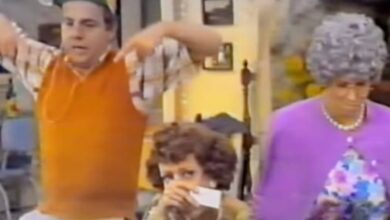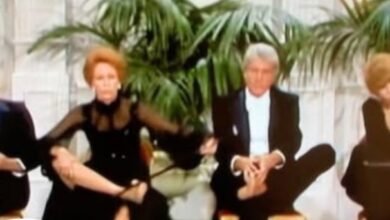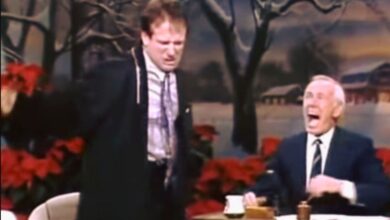George Jones’s “The Grand Tour” Redefined Country Heartbreak in 1974
When George Jones released “The Grand Tour” in 1974, he wasn’t just unveiling another country heartbreak song—he was opening the door to a new era of emotional storytelling in country music. Written by Norro Wilson, George Richey, and Carmol Taylor, the song shot to No. 1 on the Billboard Hot Country Singles chart and quickly etched itself into the fabric of the genre. Its somber, stripped-down narrative—a guided walk through an empty house, where each room echoes with the pain of lost love—offered a rawness and realism that was rarely heard with such clarity at the time. “The Grand Tour” wasn’t just a hit; it was a masterclass in restraint and devastation, becoming one of Jones’s most defining works.
George Jones, already known as “The Possum,” had long been a staple of the country world by the time “The Grand Tour” emerged. Born in Saratoga, Texas, and raised in the hardscrabble reality of Depression-era poverty, Jones’s voice carried the grit of his upbringing. He began performing in the 1950s and soon built a reputation for his unparalleled phrasing and emotional delivery. By the early ’70s, he had a string of hits under his belt, yet “The Grand Tour” represented a turning point—an elevation in artistic depth that separated him even further from his peers.
The story behind the song is nearly as poignant as the lyrics themselves. Co-writer Norro Wilson reportedly drew inspiration from the breakdown of his own marriage, and together with Richey and Taylor, they crafted a song that avoided melodrama in favor of slow-burning sorrow. The idea was simple—a man walking through his empty house, pointing out remnants of a life that once was. But within that simplicity lay its power. The final twist—when the narrator invites us to view “the nursery”—left listeners reeling. This wasn’t just a breakup; it was a loss of family, of identity, of purpose.
Recording “The Grand Tour” was an exercise in atmosphere. Produced by Billy Sherrill, the song’s arrangement was minimal but lush, built around a slow tempo that let Jones’s vocals breathe. The production featured strings and pedal steel guitar, but they were used with restraint. The centerpiece was always Jones’s aching voice, full of pauses and emotional cracks. He never over-sang it, which made the pain more palpable. Sherrill, who had also guided Tammy Wynette’s best work, knew exactly how to frame a voice like Jones’s—giving it just enough room to haunt the listener.
Upon its release, “The Grand Tour” was met with immediate acclaim. It spent a week at No. 1 and remained on the chart for over a dozen weeks. Critics hailed it as one of Jones’s best recordings, and fans instantly gravitated toward its storytelling depth. It wasn’t just the sad story—it was the way Jones made it feel lived-in. In an era where country music often leaned toward novelty or uptempo hits, this song slowed everything down and reminded audiences what real country sorrow sounded like.
Culturally, the song carved out a new lane for the genre. It wasn’t about honky-tonk nights or cheating tales—it was about grief. It brought a kind of emotional gravitas that many listeners, especially those dealing with divorce or familial loss, connected with deeply. “The Grand Tour” became more than just a song; it became a companion for those enduring their own silent house tours of the heart. Its success paved the way for more serious subject matter in country radio.
For Jones, “The Grand Tour” marked a pivotal moment. Though his life off-stage was riddled with chaos—alcohol abuse, a collapsing marriage to Tammy Wynette, financial troubles—this song reaffirmed his place as country’s greatest voice. It widened his audience, drew in critics who previously dismissed him as “just another balladeer,” and even brought renewed respect among Nashville’s elite. It was the kind of performance that transcended the turmoil of the man behind the mic.
Its influence didn’t end with Jones’s career. “The Grand Tour” became a blueprint for how to structure sorrow in a song. You could draw a direct line from its narrative approach to later classics like Randy Travis’s “On the Other Hand” or Alan Jackson’s “Here in the Real World.” The song proved that country could be literary, emotional, and sonically elegant all at once. It also inspired a new wave of artists to embrace storytelling not just as a device, but as a core of the genre’s identity.
Over the years, many artists have attempted to interpret “The Grand Tour,” but few have captured its essence like Aaron Neville did in his 1993 cover. His soulful voice gave the song a new texture, introducing it to a broader, more R&B-influenced audience. While some purists resisted the reimagining, others praised it as a sign of the song’s universality—its themes of loss and longing weren’t exclusive to country fans; they were human truths.
At the time of its release, Jones’s personal life mirrored the desolation of the song. His marriage to Tammy Wynette was crumbling, and his addictions were escalating. That contrast—between the perfection of the performance and the imperfection of the performer—gave “The Grand Tour” an added layer of vulnerability. When Jones sang about walking through an empty nursery, many wondered how much of it was fiction and how much was confession.
Decades later, the song’s legacy remains intact. It regularly appears on “greatest country songs of all time” lists and is still played on classic country stations across America. Country Music Television (CMT) and Rolling Stone have both ranked it among Jones’s essential recordings. Younger artists, including Chris Stapleton and Jason Isbell, have cited it as an influence on their writing and approach to emotional storytelling.
From a technical standpoint, “The Grand Tour” also influenced how producers approached ballads in Nashville. Sherrill’s use of space, tension, and subtle orchestration became a model for countless producers in the decades to follow. It proved that restraint could be more powerful than bombast, especially when paired with a voice as expressive as Jones’s.
In the years following Jones’s death in 2013, the song took on even more weight. It was played at tribute concerts and memorials, a testament to its lasting emotional impact. Fans often mention “The Grand Tour” as the song that introduced them to George Jones or the one they turn to during life’s hardest moments. It has become a kind of emotional landmark in the country canon.
Ultimately, “The Grand Tour” endures because it doesn’t just tell a story—it invites you inside it. Every room, every silence, every word is heavy with meaning. George Jones didn’t just sing about heartbreak; he embodied it. And with this song, he offered listeners a mirror to their own sorrow and a reminder that even in the loneliest house, someone else has walked those halls before.





